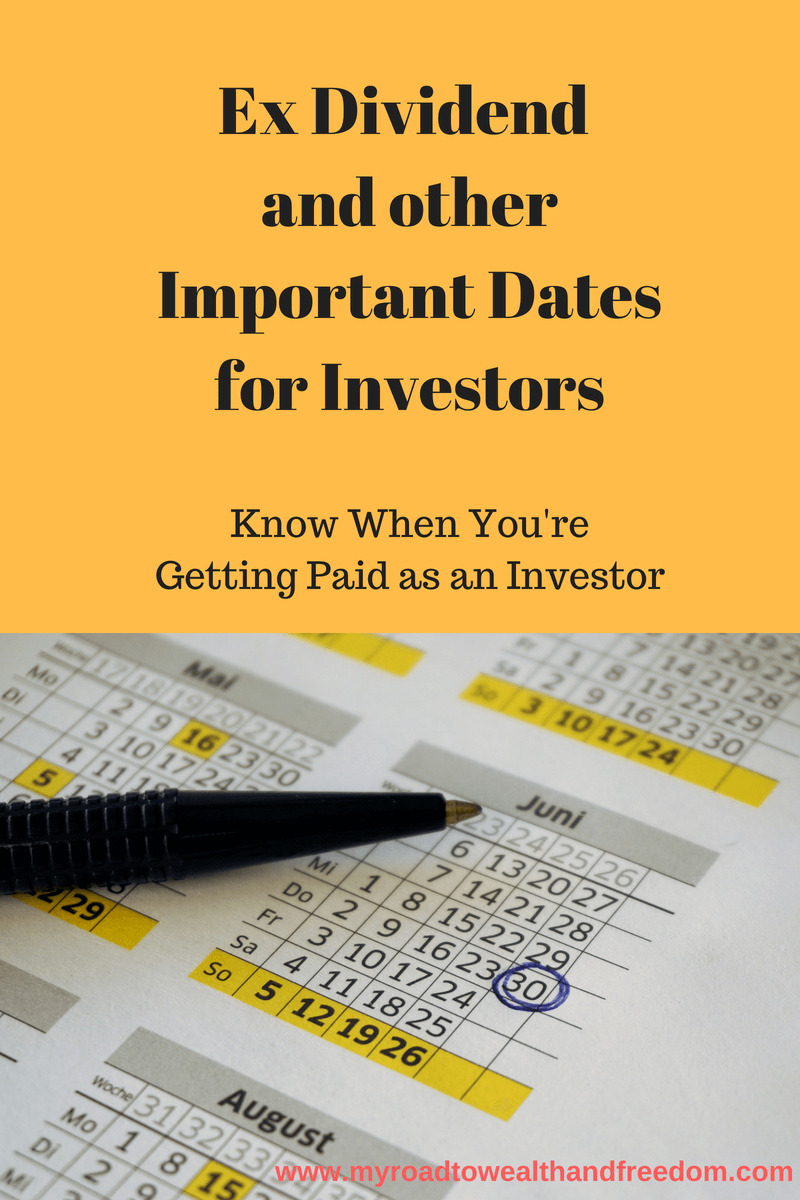In this post I look at the Ex-Dividend date and Other Important Dividend Dates for Investors. So you’ve purchased a nice collection of dividend paying stocks and you’re anxiously awaiting the stream of dividend income that those shares will provide. Then the dividend payment date comes and goes and you didn’t get paid! What happened? In this post I look at some important dividend dates for investors and how to read a company press release when it declares dividends.
Dividend Declaration Date
Most dividend paying companies declare dividends when they report their quarterly earnings. They do so through a press release. This date is called a declaration date. Let’s look at the example below from TD Bank (TD).

TD Bank Group declares dividends
Dec 4, 2014
(all amounts in Canadian dollars)
TORONTO, Dec. 4, 2014 /CNW/ – The Toronto-Dominion Bank (the Bank) today announced that a dividend in an amount of forty-seven (47 cents) per fully paid common share in the capital stock of the Bank has been declared for the quarter ending January 31, 2015, payable on and after January 31, 2015, to shareholders of record at the close of business on January 6, 2015.
In lieu of receiving their dividends in cash, holders of the Bank’s common shares may choose to have their dividends reinvested in additional common shares of the Bank in accordance with the Dividend Reinvestment Plan (the Plan).
Under the Plan, the Bank has the discretion to either purchase the additional common shares in the open market or issue them from treasury. If issued from treasury, the Bank may decide to apply a discount of up to 5% to the Average Market Price (as defined in the Plan) of the additional shares. For the January 31, 2015 dividend, the Bank will issue the additional shares from treasury, with no discount.
See full press release here.
The above excerpt gives investors a lot of information to digest. So let’s take a closer look.
First off, it’s an announcement to the company’s shareholders that they will be getting paid $0.47 for each and every common share they own. It’s always nice to know how much you’ll be paid so the first critical piece of information states just that. If the declared dividend is an increase (or decrease) over the previous one, then there will be a mention of this in the press release.
Dividend Payment Date
The next key piece of information is the payment date. In this case it is payable on or after January 31, 2015. If January 31 is a regular business day, then you will be paid on that day. If, however, January 31 falls on a weekend, then you will be paid on the next business day.
Record Date
Another key piece of information is the record date. In our example it states that the dividend will be paid to shareholders of record at the close of the business day on January 6, 2015. This information is vital in determining by which date you need to purchase the shares by to be able to get the dividend.
So let’s figure it out. Those with experience in buying and selling shares through a broker or an online discount brokerage account know that it takes 3 full business days for a transaction to settle. So January 6 was a Tuesday. If we count back 3 business days, we get to Friday January 2. This is where most people make their mistake. Yes Friday is 3 business days, however, if you bought TD shares on this day the trade would settle on January 7! That’s because Friday is not technically 3 full business days.
Ex-Dividend Date
In fact Friday is what’s called the ex-dividend date. This is without question the trickiest date of them all because many investors try to “capture” the dividend by trying to buy shares just before the dividend record date. What makes the ex-dividend date tricky is that there is no mention made of it in a company’s press release when they declare the dividends.
The ex-dividend date is simply the date on which a stock will trade without a buyer receiving a dividend. Usually on ex-dividend dates a stock will trade lower by about the amount of the dividend to reflect that reality. The ex-dividend date is the date that investors look for in order to figure out the deadline by which they must purchase the shares in order to receive the dividend.
So in our example above, the shares of TD traded with the dividend on Wednesday, December 31 (Thursday was New Year’s Day and stock exchanges were closed). You would have had to buy them on or by December 31 in order to receive the January 31 dividend payment.
Dividend Re-Investment Plan Discount
The final piece of important information contained in the above press release involves the dividend re-investment plan. Dividend re-investment plans are great ways for investors to slowly increase their holdings in a company over time. I’ve written a few posts on the subject of DRIPs that you can check out here. What I look for in a company’s press release when they declare dividends is whether or not they will issue a discount on any shares purchased through the dividend re-investment plan.
When a company offers the option of re-investing the dividends I view that as a bonus because I get to increase my holdings in a company without paying any commissions or fees. When they offer a discount of between 2-5% that is just icing on the cake. Not long ago virtually every Canadian bank offered a discount on re-invested dividends as they needed to conserve cash through the financial crisis. As the situation began to improve, all of them have since eliminated the discount as seen in the example above. But that is always subject to change.
Image courtesy of Stuart Miles / FreeDigitalPhotos.net

Great job. Solid explanations on dividend date which can be very confusing to many people.
BeSmartRich